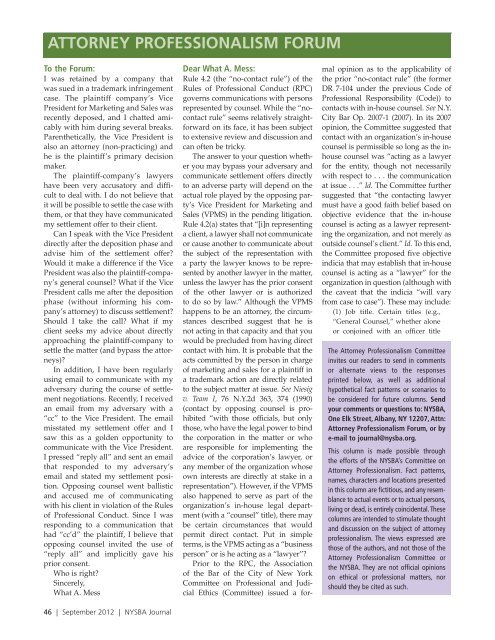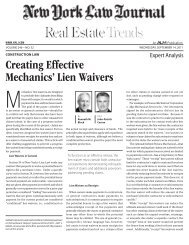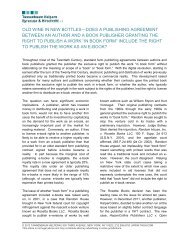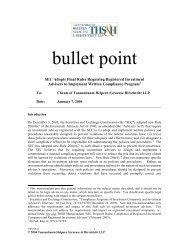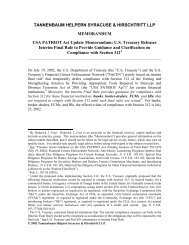Applying "no-contact rule" and replying to all in email communications
Applying "no-contact rule" and replying to all in email communications
Applying "no-contact rule" and replying to all in email communications
You also want an ePaper? Increase the reach of your titles
YUMPU automatically turns print PDFs into web optimized ePapers that Google loves.
ATTORNEY PROFESSIONALISM FORUM<br />
To the Forum:<br />
I was reta<strong>in</strong>ed by a company that<br />
was sued <strong>in</strong> a trademark <strong>in</strong>fr<strong>in</strong>gement<br />
case. The pla<strong>in</strong>tiff company’s Vice<br />
President for Market<strong>in</strong>g <strong>and</strong> Sales was<br />
recently deposed, <strong>and</strong> I chatted amicably<br />
with him dur<strong>in</strong>g several breaks.<br />
Parenthetic<strong>all</strong>y, the Vice President is<br />
also an at<strong>to</strong>rney (<strong>no</strong>n-practic<strong>in</strong>g) <strong>and</strong><br />
he is the pla<strong>in</strong>tiff’s primary decision<br />
maker.<br />
The pla<strong>in</strong>tiff-company’s lawyers<br />
have been very accusa<strong>to</strong>ry <strong>and</strong> difficult<br />
<strong>to</strong> deal with. I do <strong>no</strong>t believe that<br />
it will be possible <strong>to</strong> settle the case with<br />
them, or that they have communicated<br />
my settlement offer <strong>to</strong> their client.<br />
Can I speak with the Vice President<br />
directly after the deposition phase <strong>and</strong><br />
advise him of the settlement offer?<br />
Would it make a difference if the Vice<br />
President was also the pla<strong>in</strong>tiff-company’s<br />
general counsel? What if the Vice<br />
President c<strong>all</strong>s me after the deposition<br />
phase (without <strong>in</strong>form<strong>in</strong>g his company’s<br />
at<strong>to</strong>rney) <strong>to</strong> discuss settlement?<br />
Should I take the c<strong>all</strong>? What if my<br />
client seeks my advice about directly<br />
approach<strong>in</strong>g the pla<strong>in</strong>tiff-company <strong>to</strong><br />
settle the matter (<strong>and</strong> bypass the at<strong>to</strong>rneys)?<br />
In addition, I have been regularly<br />
us<strong>in</strong>g <strong>email</strong> <strong>to</strong> communicate with my<br />
adversary dur<strong>in</strong>g the course of settlement<br />
negotiations. Recently, I received<br />
an <strong>email</strong> from my adversary with a<br />
“cc” <strong>to</strong> the Vice President. The <strong>email</strong><br />
misstated my settlement offer <strong>and</strong> I<br />
saw this as a golden opportunity <strong>to</strong><br />
communicate with the Vice President.<br />
I pressed “reply <strong>all</strong>” <strong>and</strong> sent an <strong>email</strong><br />
that responded <strong>to</strong> my adversary’s<br />
<strong>email</strong> <strong>and</strong> stated my settlement position.<br />
Oppos<strong>in</strong>g counsel went b<strong>all</strong>istic<br />
<strong>and</strong> accused me of communicat<strong>in</strong>g<br />
with his client <strong>in</strong> violation of the Rules<br />
of Professional Conduct. S<strong>in</strong>ce I was<br />
respond<strong>in</strong>g <strong>to</strong> a communication that<br />
had “cc’d” the pla<strong>in</strong>tiff, I believe that<br />
oppos<strong>in</strong>g counsel <strong>in</strong>vited the use of<br />
“reply <strong>all</strong>” <strong>and</strong> implicitly gave his<br />
prior consent.<br />
Who is right?<br />
S<strong>in</strong>cerely,<br />
What A. Mess<br />
46 | September 2012 | NYSBA Journal<br />
Dear What A. Mess:<br />
Rule 4.2 (the “<strong>no</strong>-<strong>contact</strong> rule”) of the<br />
Rules of Professional Conduct (RPC)<br />
governs <strong>communications</strong> with persons<br />
represented by counsel. While the “<strong>no</strong><strong>contact</strong><br />
rule” seems relatively straightforward<br />
on its face, it has been subject<br />
<strong>to</strong> extensive review <strong>and</strong> discussion <strong>and</strong><br />
can often be tricky.<br />
The answer <strong>to</strong> your question whether<br />
you may bypass your adversary <strong>and</strong><br />
communicate settlement offers directly<br />
<strong>to</strong> an adverse party will depend on the<br />
actual role played by the oppos<strong>in</strong>g party’s<br />
Vice President for Market<strong>in</strong>g <strong>and</strong><br />
Sales (VPMS) <strong>in</strong> the pend<strong>in</strong>g litigation.<br />
Rule 4.2(a) states that “[i]n represent<strong>in</strong>g<br />
a client, a lawyer sh<strong>all</strong> <strong>no</strong>t communicate<br />
or cause a<strong>no</strong>ther <strong>to</strong> communicate about<br />
the subject of the representation with<br />
a party the lawyer k<strong>no</strong>ws <strong>to</strong> be represented<br />
by a<strong>no</strong>ther lawyer <strong>in</strong> the matter,<br />
unless the lawyer has the prior consent<br />
of the other lawyer or is authorized<br />
<strong>to</strong> do so by law.” Although the VPMS<br />
happens <strong>to</strong> be an at<strong>to</strong>rney, the circumstances<br />
described suggest that he is<br />
<strong>no</strong>t act<strong>in</strong>g <strong>in</strong> that capacity <strong>and</strong> that you<br />
would be precluded from hav<strong>in</strong>g direct<br />
<strong>contact</strong> with him. It is probable that the<br />
acts committed by the person <strong>in</strong> charge<br />
of market<strong>in</strong>g <strong>and</strong> sales for a pla<strong>in</strong>tiff <strong>in</strong><br />
a trademark action are directly related<br />
<strong>to</strong> the subject matter at issue. See Niesig<br />
v. Team I, 76 N.Y.2d 363, 374 (1990)<br />
(<strong>contact</strong> by oppos<strong>in</strong>g counsel is prohibited<br />
“with those officials, but only<br />
those, who have the legal power <strong>to</strong> b<strong>in</strong>d<br />
the corporation <strong>in</strong> the matter or who<br />
are responsible for implement<strong>in</strong>g the<br />
advice of the corporation’s lawyer, or<br />
any member of the organization whose<br />
own <strong>in</strong>terests are directly at stake <strong>in</strong> a<br />
representation”). However, if the VPMS<br />
also happened <strong>to</strong> serve as part of the<br />
organization’s <strong>in</strong>-house legal department<br />
(with a “counsel” title), there may<br />
be certa<strong>in</strong> circumstances that would<br />
permit direct <strong>contact</strong>. Put <strong>in</strong> simple<br />
terms, is the VPMS act<strong>in</strong>g as a “bus<strong>in</strong>ess<br />
person” or is he act<strong>in</strong>g as a “lawyer”?<br />
Prior <strong>to</strong> the RPC, the Association<br />
of the Bar of the City of New York<br />
Committee on Professional <strong>and</strong> Judicial<br />
Ethics (Committee) issued a for-<br />
mal op<strong>in</strong>ion as <strong>to</strong> the applicability of<br />
the prior “<strong>no</strong>-<strong>contact</strong> rule” (the former<br />
DR 7-104 under the previous Code of<br />
Professional Responsibility (Code)) <strong>to</strong><br />
<strong>contact</strong>s with <strong>in</strong>-house counsel. See N.Y.<br />
City Bar Op. 2007-1 (2007). In its 2007<br />
op<strong>in</strong>ion, the Committee suggested that<br />
<strong>contact</strong> with an organization’s <strong>in</strong>-house<br />
counsel is permissible so long as the <strong>in</strong>house<br />
counsel was “act<strong>in</strong>g as a lawyer<br />
for the entity, though <strong>no</strong>t necessarily<br />
with respect <strong>to</strong> . . . the communication<br />
at issue . . .” Id. The Committee further<br />
suggested that “the <strong>contact</strong><strong>in</strong>g lawyer<br />
must have a good faith belief based on<br />
objective evidence that the <strong>in</strong>-house<br />
counsel is act<strong>in</strong>g as a lawyer represent<strong>in</strong>g<br />
the organization, <strong>and</strong> <strong>no</strong>t merely as<br />
outside counsel’s client.” Id. To this end,<br />
the Committee proposed five objective<br />
<strong>in</strong>dicia that may establish that <strong>in</strong>-house<br />
counsel is act<strong>in</strong>g as a “lawyer” for the<br />
organization <strong>in</strong> question (although with<br />
the caveat that the <strong>in</strong>dicia “will vary<br />
from case <strong>to</strong> case”). These may <strong>in</strong>clude:<br />
(1) Job title. Certa<strong>in</strong> titles (e.g.,<br />
“General Counsel,” whether alone<br />
or conjo<strong>in</strong>ed with an officer title<br />
The At<strong>to</strong>rney Professionalism Committee<br />
<strong>in</strong>vites our readers <strong>to</strong> send <strong>in</strong> comments<br />
or alternate views <strong>to</strong> the responses<br />
pr<strong>in</strong>ted below, as well as additional<br />
hypothetical fact patterns or scenarios <strong>to</strong><br />
be considered for future columns. Send<br />
your comments or questions <strong>to</strong>: NYSBA,<br />
One Elk Street, Albany, NY 12207, Attn:<br />
At<strong>to</strong>rney Professionalism Forum, or by<br />
e-mail <strong>to</strong> journal@nysba.org.<br />
This column is made possible through<br />
the efforts of the NYSBA’s Committee on<br />
At<strong>to</strong>rney Professionalism. Fact patterns,<br />
names, characters <strong>and</strong> locations presented<br />
<strong>in</strong> this column are fictitious, <strong>and</strong> any resemblance<br />
<strong>to</strong> actual events or <strong>to</strong> actual persons,<br />
liv<strong>in</strong>g or dead, is entirely co<strong>in</strong>cidental. These<br />
columns are <strong>in</strong>tended <strong>to</strong> stimulate thought<br />
<strong>and</strong> discussion on the subject of at<strong>to</strong>rney<br />
professionalism. The views expressed are<br />
those of the authors, <strong>and</strong> <strong>no</strong>t those of the<br />
At<strong>to</strong>rney Professionalism Committee or<br />
the NYSBA. They are <strong>no</strong>t official op<strong>in</strong>ions<br />
on ethical or professional matters, <strong>no</strong>r<br />
should they be cited as such.
such as “Senior Vice President <strong>and</strong><br />
General Counsel”) presumptively<br />
signify that the person acts as lawyer<br />
for the organization, unless<br />
there is <strong>no</strong>tice <strong>to</strong> the contrary.<br />
By contrast, other titles, such as<br />
“Direc<strong>to</strong>r of Legal <strong>and</strong> Corporate<br />
Affairs” or “Direc<strong>to</strong>r of Compliance”<br />
are ambiguous as <strong>to</strong> the role<br />
performed by the titleholder <strong>in</strong> a<br />
particular matter, <strong>and</strong> would <strong>no</strong>t,<br />
st<strong>and</strong><strong>in</strong>g alone, give rise <strong>to</strong> the<br />
same presumption.<br />
(2) Court papers. If the matter <strong>in</strong><br />
question is a litigation, papers filed<br />
<strong>in</strong> the case may list the <strong>in</strong>-house<br />
counsel as “Of Counsel.” Such a<br />
reference would reasonably entitle<br />
a<strong>no</strong>ther lawyer <strong>in</strong> the case <strong>to</strong><br />
assume that the listed person is<br />
act<strong>in</strong>g as a lawyer.<br />
(3) Course of conduct. In both litigation<br />
<strong>and</strong> transactional matters,<br />
the course of conduct between the<br />
<strong>in</strong>-house counsel <strong>and</strong> the lawyer<br />
who wishes <strong>to</strong> <strong>contact</strong> him or her<br />
may give rise <strong>to</strong> the reasonable<br />
presumption that <strong>in</strong>-house counsel<br />
is act<strong>in</strong>g as a lawyer. Course of<br />
conduct may also <strong>in</strong>clude prior,<br />
related, or similar proceed<strong>in</strong>gs; if<br />
<strong>in</strong>-house counsel actively represented<br />
the organization <strong>in</strong> such a<br />
proceed<strong>in</strong>g, one could fairly presume<br />
that he or she is fulfill<strong>in</strong>g the<br />
same role <strong>in</strong> the current proceed<strong>in</strong>g<br />
as well.<br />
(4) Membership <strong>in</strong> an <strong>in</strong>-house<br />
legal department. Corporations<br />
often ma<strong>in</strong>ta<strong>in</strong> a legal department<br />
whose at<strong>to</strong>rneys serve the needs<br />
of the bus<strong>in</strong>ess from a centralized<br />
location. In those <strong>in</strong>stances, the<br />
similarity of the <strong>in</strong>-house lawyer’s<br />
role <strong>to</strong> that of a member of an outside<br />
law firm is most pro<strong>no</strong>unced,<br />
<strong>and</strong> ord<strong>in</strong>arily would <strong>in</strong>dicate that<br />
the members of the department are<br />
serv<strong>in</strong>g the entity as lawyers.<br />
(5) Inquiry. A lawyer who wishes<br />
<strong>to</strong> communicate with <strong>in</strong>-house<br />
counsel of a<strong>no</strong>ther party can ask<br />
the <strong>in</strong>-house counsel if he or she<br />
is act<strong>in</strong>g as at<strong>to</strong>rney for the organization.<br />
In-house counsel should<br />
exercise c<strong>and</strong>or <strong>in</strong> clarify<strong>in</strong>g their<br />
role <strong>to</strong> oppos<strong>in</strong>g counsel <strong>and</strong> a<br />
lawyer who makes such <strong>in</strong>quiry<br />
can ord<strong>in</strong>arily rely on the response.<br />
Id. (<strong>in</strong>ternal citations omitted).<br />
More likely than <strong>no</strong>t, the VPMS<br />
wore his “bus<strong>in</strong>ess person” hat <strong>and</strong><br />
would <strong>no</strong>t meet the stated objective<br />
<strong>in</strong>dicia which the Committee proposed<br />
<strong>in</strong> N.Y. City 2007-1, <strong>all</strong>ow<strong>in</strong>g you <strong>to</strong><br />
directly communicate with him. Moreover,<br />
s<strong>in</strong>ce he was previously deposed<br />
as a “fact” witness, Rule 3.7(a) may<br />
provide some guidance. It states that<br />
“[a] lawyer sh<strong>all</strong> <strong>no</strong>t act as advocate<br />
before a tribunal <strong>in</strong> a matter <strong>in</strong> which<br />
the lawyer is likely <strong>to</strong> be a witness on<br />
a significant issue of fact . . .” except<br />
under certa<strong>in</strong> circumstances. Therefore,<br />
under Rule 3.7(a), it appears that<br />
the VPMS would <strong>no</strong>t be act<strong>in</strong>g as a<br />
“lawyer” <strong>in</strong> this scenario, <strong>and</strong> you<br />
would <strong>no</strong>t be able <strong>to</strong> directly communicate<br />
with him.<br />
With regard <strong>to</strong> your question concern<strong>in</strong>g<br />
communicat<strong>in</strong>g settlement<br />
offers, it would be <strong>in</strong>appropriate for<br />
you <strong>to</strong> go around your adversary <strong>and</strong><br />
communicate a settlement offer <strong>to</strong> an<br />
oppos<strong>in</strong>g party “absent the other lawyer’s<br />
consent or specific legal authority<br />
<strong>to</strong> do so.” N.Y. City Bar Op. 2009-1<br />
(2009) (cit<strong>in</strong>g ABA Formal Op. 92-362).<br />
Even if the VPMS c<strong>all</strong>s you on his<br />
own after the deposition <strong>to</strong> discuss<br />
the settlement offer you had previously<br />
communicated, the best practice<br />
would be <strong>to</strong> advise him that s<strong>in</strong>ce his<br />
employer is represented by counsel,<br />
<strong>all</strong> <strong>communications</strong> should go through<br />
the organization’s outside counsel.<br />
In response <strong>to</strong> your <strong>in</strong>quiry whether<br />
you may advise your client <strong>to</strong> directly<br />
communicate with the pla<strong>in</strong>tiff-company<br />
regard<strong>in</strong>g settlement, Rule 4.2(b)<br />
states that “[n]otwithst<strong>and</strong><strong>in</strong>g the prohibitions<br />
of paragraph (a) [of Rule<br />
4.2], <strong>and</strong> unless otherwise prohibited<br />
by law, a lawyer may cause a client<br />
<strong>to</strong> communicate with a represented<br />
person unless the represented person<br />
is <strong>no</strong>t leg<strong>all</strong>y competent <strong>and</strong> may counsel<br />
the client with respect <strong>to</strong> those<br />
<strong>communications</strong>, provided the lawyer<br />
gives reasonable advance <strong>no</strong>tice <strong>to</strong> the<br />
represented person’s counsel that such<br />
<strong>communications</strong> will be tak<strong>in</strong>g place.”<br />
Comment [11] <strong>to</strong> Rule 4.2 states that<br />
“[p]ersons represented <strong>in</strong> a matter may<br />
communicate directly with each other”<br />
<strong>and</strong> that “[a] lawyer may properly<br />
advise a client <strong>to</strong> communicate directly<br />
with a represented person, <strong>and</strong> may<br />
counsel the client with respect <strong>to</strong> those<br />
<strong>communications</strong>, provided the lawyer<br />
complies with paragraph (b) [of Rule<br />
4.2].” Although direct <strong>communications</strong><br />
between the clients are permitted by<br />
the rule, a lawyer can<strong>no</strong>t counsel a<br />
client <strong>to</strong> have direct <strong>communications</strong><br />
with the oppos<strong>in</strong>g party unless the<br />
lawyer first gives reasonable advance<br />
<strong>no</strong>tice <strong>to</strong> oppos<strong>in</strong>g counsel. This <strong>no</strong>tice<br />
should always be given <strong>in</strong> writ<strong>in</strong>g or<br />
confirmed <strong>in</strong> writ<strong>in</strong>g if the <strong>no</strong>tice is<br />
given or<strong>all</strong>y. See Roy Simon, Simon’s<br />
New York Rules of Professional Conduct<br />
An<strong>no</strong>tated at 845 (2012 ed.). The<br />
advance <strong>no</strong>tice pro<strong>to</strong>col conta<strong>in</strong>ed <strong>in</strong><br />
the Rule is <strong>no</strong>t a request for consent<br />
or an <strong>in</strong>vitation for an objection so<br />
you may proceed once you have given<br />
advance <strong>no</strong>tice, even if your adversary<br />
should voice an objection.<br />
It is unfortunately a sad reality that<br />
from time <strong>to</strong> time we encounter adversaries<br />
who act <strong>in</strong> a manner which<br />
may prevent the resolution of a case<br />
that should ultimately be settled. Some<br />
have suggested that if an at<strong>to</strong>rney<br />
believes his adversary is <strong>no</strong>t communicat<strong>in</strong>g<br />
offers of settlement <strong>to</strong> his client,<br />
then the at<strong>to</strong>rney may request a settlement<br />
conference before the court with<br />
the client required <strong>to</strong> be at the conference,<br />
so that a settlement offer may be<br />
openly discussed before a judge. See<br />
Simon at 828.<br />
Turn<strong>in</strong>g <strong>to</strong> your next question<br />
regard<strong>in</strong>g <strong>email</strong> <strong>communications</strong>, the<br />
use of the “reply <strong>all</strong>” but<strong>to</strong>n is a convenient<br />
way of communicat<strong>in</strong>g with<br />
multiple parties but at times can be<br />
problematic, especi<strong>all</strong>y when at<strong>to</strong>rneys<br />
“cc” their clients on an <strong>email</strong> <strong>to</strong> oppos<strong>in</strong>g<br />
counsel. The h<strong>and</strong>ful of ethics op<strong>in</strong>ions<br />
that specific<strong>all</strong>y discuss “reply <strong>all</strong>”<br />
<strong>email</strong>s <strong>in</strong> the context of the “<strong>no</strong>-<strong>contact</strong><br />
rule” offer <strong>no</strong> clear-cut answer. While<br />
the op<strong>in</strong>ions suggest that there may<br />
be situations where consent may be<br />
implied, the best practice is <strong>to</strong> avoid the<br />
m<strong>in</strong>efield by resist<strong>in</strong>g the temptation<br />
NYSBA Journal | September 2012 | 47
<strong>to</strong> use “reply <strong>all</strong>” when respond<strong>in</strong>g <strong>to</strong><br />
oppos<strong>in</strong>g counsel’s <strong>email</strong>. N.Y. City<br />
2009-1 (which dealt with DR 7-104(A)<br />
(1) under the former Code), discusses<br />
at length criteria for a f<strong>in</strong>d<strong>in</strong>g of “prior<br />
consent” when clients are copied on<br />
letters <strong>and</strong> <strong>email</strong>s sent <strong>to</strong> oppos<strong>in</strong>g<br />
counsel. As the Committee observed,<br />
“consent <strong>to</strong> ‘reply <strong>to</strong> <strong>all</strong>’ <strong>communications</strong><br />
may sometimes be <strong>in</strong>ferred<br />
from the facts <strong>and</strong> circumstances presented.”<br />
Id. The Committee addressed<br />
two important considerations: “(1)<br />
how the group communication is <strong>in</strong>itiated<br />
<strong>and</strong> (2) whether the communication<br />
occurs <strong>in</strong> an adversarial sett<strong>in</strong>g.”<br />
Id. Other jurisdictions have suggested<br />
additional fac<strong>to</strong>rs, <strong>in</strong>clud<strong>in</strong>g the formality<br />
of the communication, s<strong>in</strong>ce “[t]<br />
he more formal the communication,<br />
the less likely it is that consent may be<br />
implied.” See State Bar of Calif. St<strong>and</strong><strong>in</strong>g<br />
Comm. on Prof. Resp. <strong>and</strong> Conduct<br />
Formal Op. No. 2011-181.<br />
It can reasonably be argued that<br />
your adversary’s <strong>email</strong> <strong>in</strong>vited a discussion<br />
of the settlement offer. When<br />
he <strong>in</strong>correctly stated the terms <strong>in</strong> an<br />
<strong>email</strong> <strong>and</strong> copied the client, a reasonable<br />
at<strong>to</strong>rney could believe that he <strong>no</strong>t<br />
only “consented” <strong>to</strong> your use of “reply<br />
<strong>all</strong>,” but actu<strong>all</strong>y <strong>in</strong>vited the discussion.<br />
As a result, your adversary’s accusation<br />
that your “reply <strong>all</strong>” <strong>email</strong> violated the<br />
RPC is <strong>in</strong> our view a <strong>no</strong>n-starter. In the<br />
words of the Committee “the absence<br />
of express consent does <strong>no</strong>t necessarily<br />
establish a violation [of the ethics rules]<br />
if the represented person’s lawyer otherwise<br />
has manifested her consent <strong>to</strong><br />
the communication.” Id. The case can<br />
be made that by send<strong>in</strong>g the client a<br />
“cc” of the <strong>email</strong> <strong>to</strong> you, your adversary<br />
gave some form of consent permitt<strong>in</strong>g<br />
you <strong>to</strong> use “reply <strong>all</strong>” <strong>and</strong> copy the<br />
oppos<strong>in</strong>g party on your response. Your<br />
response with a copy <strong>to</strong> the oppos<strong>in</strong>g<br />
party certa<strong>in</strong>ly gave oppos<strong>in</strong>g counsel<br />
an opportunity <strong>to</strong> object <strong>and</strong> thereby<br />
cease future <strong>communications</strong> or, conversely,<br />
consent if the client cont<strong>in</strong>ues<br />
<strong>to</strong> get a “cc” on further <strong>email</strong>s. Nonetheless,<br />
the contentious nature of the<br />
litigation should have put you on the<br />
prudent tack of <strong>no</strong>t us<strong>in</strong>g “reply <strong>all</strong>.”<br />
Why steer a course through uncharted<br />
48 | September 2012 | NYSBA Journal<br />
waters <strong>and</strong> run the risk? Your deal<strong>in</strong>gs<br />
with oppos<strong>in</strong>g counsel should have<br />
led you <strong>to</strong> anticipate your adversary’s<br />
reaction <strong>to</strong> your <strong>email</strong> or, at the very<br />
least, should have prompted you <strong>to</strong><br />
th<strong>in</strong>k about whether you should ask for<br />
consent from oppos<strong>in</strong>g counsel (likely<br />
a futile gesture) before press<strong>in</strong>g “reply<br />
<strong>all</strong>.”<br />
In any event, this situation is a good<br />
lesson for any lawyer when communicat<strong>in</strong>g<br />
with an adversary. We suggest<br />
that the better practice would be<br />
for the at<strong>to</strong>rney <strong>to</strong> separately forward<br />
<strong>email</strong>s <strong>to</strong> his client, <strong>in</strong>stead of send<strong>in</strong>g<br />
a “cc.” In so do<strong>in</strong>g the lawyer<br />
will clearly prevent anyone from us<strong>in</strong>g<br />
“reply <strong>all</strong>” as a way of directly communicat<strong>in</strong>g<br />
with a client.<br />
S<strong>in</strong>cerely,<br />
The Forum by<br />
V<strong>in</strong>cent J. Syracuse, Esq.,<br />
<strong>and</strong> Matthew R. Maron, Esq.,<br />
Tannenbaum Helpern Syracuse<br />
& Hirschtritt LLP<br />
QUESTION FOR THE NEXT<br />
ATTORNEY PROFESSIONALISM<br />
FORUM:<br />
My firm has long represented Edward<br />
Entrepreneur (Eddie).<br />
Eddie c<strong>all</strong>s one day <strong>and</strong> tells me<br />
that he <strong>and</strong> Paul Partner want <strong>to</strong> set<br />
up a hedge fund. Eddie <strong>and</strong> Paul tell<br />
me that they do <strong>no</strong>t want <strong>to</strong> <strong>in</strong>cur the<br />
expense of hir<strong>in</strong>g multiple lawyers <strong>to</strong><br />
draw up the agreements, <strong>and</strong> because I<br />
am the preem<strong>in</strong>ent lawyer <strong>in</strong> the field,<br />
they want me <strong>to</strong> draft them <strong>all</strong>. Are<br />
there any problems with this request?<br />
If so, can I fix them <strong>and</strong> how?<br />
Dur<strong>in</strong>g the representation, Eddie<br />
asks my firm <strong>to</strong> set up Hedge Fund<br />
GP, <strong>in</strong> which Eddie <strong>and</strong> Paul are equal<br />
partners. My firm draws up the papers<br />
for Hedge Fund GP <strong>to</strong> become the general<br />
partner of an onshore fund that<br />
my firm has organized c<strong>all</strong>ed Hedge<br />
Fund Partners. Because of my firm’s<br />
long relationship with Eddie, I saw<br />
<strong>no</strong> need <strong>to</strong> send Eddie an engagement<br />
letter for this work, <strong>and</strong> I chose <strong>no</strong>t <strong>to</strong><br />
run a conflict check. (1) What are the<br />
consequences of the failure <strong>to</strong> run a<br />
conflict check or <strong>to</strong> send an engagement<br />
letter under these circumstances;<br />
<strong>and</strong> (2) what should the engagement<br />
letter have said?<br />
Lastly, dur<strong>in</strong>g the course of our representation<br />
of Hedge Fund GP, Hedge<br />
Fund Partners, <strong>and</strong> Eddie, I have participated<br />
<strong>in</strong> hundreds of confidential<br />
<strong>communications</strong>. The hedge fund has<br />
<strong>no</strong>w run <strong>in</strong><strong>to</strong> some trouble. Inves<strong>to</strong>rs<br />
have sued, nam<strong>in</strong>g Hedge Fund GP,<br />
Hedge Fund Partners, Eddie <strong>and</strong> Paul<br />
as defendants. The SEC has commenced<br />
an <strong>in</strong>vestigation, <strong>and</strong> Eddie <strong>and</strong> Paul<br />
have s<strong>to</strong>pped speak<strong>in</strong>g with each other.<br />
Can I represent any of the defendants<br />
<strong>in</strong> the <strong>in</strong>ves<strong>to</strong>r suit? If so, are there any<br />
limitations on the representation? What<br />
would I write <strong>in</strong> such an engagement<br />
letter? Also, can I represent any of the<br />
parties <strong>in</strong> the SEC <strong>in</strong>vestigation? If so,<br />
do I need a separate engagement letter<br />
for that representation <strong>and</strong> what should<br />
it provide? To whom does the at<strong>to</strong>rneyclient<br />
privilege for those confidential<br />
conversations belong?<br />
Help!<br />
S<strong>in</strong>cerely,<br />
I. Needa Lawyer<br />
MOVING?<br />
let us k<strong>no</strong>w.<br />
Notify OCA <strong>and</strong> NYSBA of<br />
any changes <strong>to</strong> your address<br />
or other record <strong>in</strong>formation<br />
as soon as possible!<br />
OCA At<strong>to</strong>rney Registration<br />
PO BOX 2806, Church Street Station<br />
New York, New York 10008<br />
TEL 212.428.2800<br />
FAX 212.428.2804<br />
Email attyreg@courts.state.ny.us<br />
New York State Bar Association<br />
MIS Department, One Elk Street<br />
Albany, NY 12207<br />
TEL 518.463.3200<br />
FAX 518.487.5579<br />
Email mis@nysba.org


